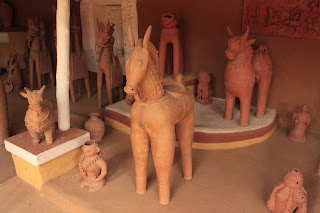In 2014, I spent a week in Spain. I based myself out of Barcelona, and spent a majority of my time there, but I also did short day trips to a few places, including the beautiful city of Zaragoza. Zaragoza is a fairly large city, but it has a compact city centre with most of the sights within walking distance of each other, so that made things extremely convenient for me.
Zaragoza is the capital of the
Spanish province of Aragon. The city has a population of almost 700,000 and is
Spain’s 5th largest city after Madrid,
Barcelona, Valencia and Seville. The city is best known for its large
basilica, the Basilica de Nuestra Senora del
Pilar. The basilica lies in the heart of the city, at the Plaza
del Pilar, the city’s main square. At one end of the square lies the city’s other main attraction, the Cathedral. Zaragoza dates back to the Roman period in the 1st century BC,
and there are Roman ruins
visible. The Goths took
control of the city in the 5th century AD,
and later the Arabs took over in the 7th century
AD. In the 12th century AD, it became the
capital of the Kingdom of Aragon.
The Basilica de Nuestra
Senora del Pilar is
a Roman Catholic church dedicated to Mary and is supposed to be the first
church in history to be dedicated to Mary. The present church dates back to the
17th century AD, when it was built by Charles II, King of Spain. The basilica stands
out because of its sheer size (130 meters x 67 meters), its eleven cupolas and
it four towering pillars. According to popular legend, soon after the Crucifixion, St James went to Spain where he preached the Gospel. One day while praying, he saw an apparition of the Virgin. She is supposed to have given him a small wooden statue of herself and a jasper column, and she is supposed to have told him to build a church. St James built a small chapel in her honour. St James returned to Jerusalem and was executed in 44 AD, but his disciples took his body to Spain and buried it there. The original chapel was destroyed and over the centuries many shrines have come and gone at the site, but the wooden statue of the Pillar has remained intact. Today it lies in the Our Lady Chapel at the Basilica de Nuestra Senora del Pilar. The Plaza
del Pilar is
a large square in the heart of the city. The square has the Basilica de Nuestra Senora del Pilar as well as the
Cathedral, the two most famous landmarks in the city. The square is full of
restaurants and cafes and is a favourite with locals and tourists alike.
 |
| Basilica de Nuestra Senora del Pilar |
 |
Main Cupola,
Basilica de Nuestra Senora del Pilar |
 |
Our Lady Chapel,
Basilica de Nuestra Senora del Pilar |
 |
Close up of Our Lady Chapel,
Basilica de Nuestra Senora del Pilar |
 |
High Altar,
Basilica de Nuestra Senora del Pilar |
 |
Cupola Interior,
Basilica de Nuestra Senora del Pilar |
The Plaza del Pilar is a large square in the heart of the city. The square has the Basilica de Nuestra Senora del Pilar as well as the Cathedral, the two most famous landmarks in the city. The square is full of restaurants and cafes and is a favourite with locals and tourists alike. It also has the Foro Museum.
 |
Foro Museum,
Plaza del Pilar |
 |
Basilica de Nuestra Senora del Pilar,
View from Caller de Alfonso I, just beyond
Plaza del Pilar |
The Cathedral, also known as La Seo, was consecrated in 1318. It stands at one end of Plaza
del Pilar, not far from the
Basilica de Nuestra Senora del Pilar. The tower was added
much later, in the beginning of the 18th century. The
cathedral was built on the site of the ancient Roman Forum of Augustus and of a
mosque, which was demolished in the 12th century AD, after
Alfonso I arrived in the city.
 |
| Zaragoza Cathedral |
 |
| High Altar, Zaragoza Cathedral |
The Museo Pablo Gargallo has an impressive
collection of works by the Aragonese sculptor, Pablo Gargallo [1881 – 1934]. The sculptor spent a lot of his life in
Barcelona and Paris, and died of pneumonia at the fairly young age of 53. He
was a friend to other famous artists of the time, including Picasso and Gris.
The museum was opened in 1985 in his former birthplace and early home.
 |
Academia,
Museo Pablo Gargallo |
 |
David,
Museo Pablo Gargallo |
 |
Horse,
Museo Pablo Gargallo |
 |
Homage to Chagall,
Museo Pablo Gargallo |
 |
Torso of an Adolescent,
Museo Pablo Gargallo |
I really enjoyed my day in Zaragoza. The distance from Barcelona to Zaragoza is over 300 km (Zaragoza is roughly halfway between Barcelona and Madrid), but the super fast trains covered the journey in less than 2 hours. Walking around the pedestrianized city centre, stopping at will at some of the many cafes, and seeing the beautiful churches, museums and architecture were all amazing experiences!







































